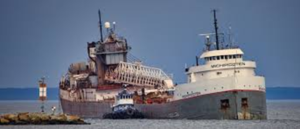The Hull Failure of S.S. Michipicoten:
The Hull Failure of S.S. Michipicoten:
Unseen Dangers on the Great Lakes
Emma Crossett
Port2Port - 2025
The Great Lakes, often called inland seas, present serious challenges to ships despite being far from the ocean. Strong currents, deep waters, and harsh weather, pose risks even to modern vessels.1 A recent incident involving the Michipicoten highlights this danger. On June 8, 2024, while sailing on Lake Superior, the ship suffered a hull failure, seen here in figure 12, forcing the crew to battle rising water and a dangerous list.3 The Michipicoten's history of service since 1952, emphasizes that even well-maintained ships are vulnerable to hull stress and fatigue, reminding us of the ongoing dangers on the Great Lakes.4

Figure 1: Michipicoten Listing Due to Hull Crack.
A Long History of Service
The Michipicoten, originally launched in 1952 as the Elton Hoyt II, has had a long and tough career on the Great Lakes.5 The vessel was acquired by Lower Lakes Towing in 2003 and renamed Michipicoten.6 Despite its decades of service, the ship continued to battle the wear and tear of Great Lakes shipping, reflecting the ongoing strain on vessels that spend their lives navigating these waters. Today, its future remains uncertain, as officials are still determining whether the ship can be safely repaired and returned to service.7
Hull Stress and Fatigue
Hull stress and fatigue occur when a ship's metal structure weakens over time due to constant pressure from heavy loads, rough weather, and repeated voyages. The metal gradually loses its ability to handle these strains, leading to cracks and, in severe cases, catastrophic structural failures. The Michipicoten's recent hull failure is a clear example of this risk. This issue is not isolated. The Daniel J. Morrell, another bulk cargo ship, met a similar fate during a violent storm on Lake Huron in November 1966. The ship split in half, with only one survivor to tell the tale.8 Both the Morrell and the Michipicoten were bulk-cargo ships, often carrying iron ore, and both survived many rough Great Lakes storms before their hulls finally gave way. These examples show a troubling pattern of hull failures among older ships, demonstrating that decades of service, no matter how resilient the ship, significantly increase the risk of hull fatigue and failure.
Environmental Impact
The Great Lakes' unpredictable weather, especially ice and storms, adds significant stress to a ship's hull. Ice buildup increases weight and pressure, while storms cause ships to flex as they plow through waves. Some flexing is normal, but when repeated in areas not designed to handle it, this motion weakens the hull. Over time, this can lead to cracks or even catastrophic failures. The Michipicoten's 2024 incident highlights the serious consequences of these forces combined with improper cargo loading.
In this case, the ship developed a "hog," a condition where the hull bends upward in the middle due to uneven cargo distribution.9 This improper loading placed excessive stress on the hull, which, along with years of wear from harsh weather, resulted in a 13-foot crack. A deckhand confirmed that the improper loading caused the hog, which played a major role in the vessel's structural failure. Luckily, the crew was able to respond appropriately, as the incident occurred in calm weather with good visibility.10 In harsher conditions, the situation could have quickly turned deadly, reminding us of the dangers ships and their crews face on the Great Lakes.
Safety Measures
Today's safety regulations aim to reduce risks, but they cannot eliminate them. Transport Canada requires vessels to conduct frequent drills, maintain survival suits and lifeboats, and ensure that ships undergo regular inspections.11 These measures are designed to protect crews and ships from the worst of the Great Lakes' conditions. However, risks remain, particularly for older ships like the Michipicoten, whose long service makes them more vulnerable to stress and fatigue. Although Transport Canada determined that the Michipicoten incident was unlikely to result in new safety protocols, it highlights the ongoing need for vigilance and maintenance in a hazardous environment.12
Even with modern safety measures in place, the dangers of navigating the Great Lakes remain, especially for ships that have endured years of stress. The Michipicoten's failure is a stark reminder of the hidden risks that ships face, both from the elements and from human error, as they continue to sail these unpredictable waters.
-
Victor Kiprop, The Great Lakes by Depth, World Atlas, Oct. 30, 2019. ↩
-
Figure 1: [Michipicoten Listing Due to Hull Crack], photograph, Associated Press, Jun. 11, 2024. ↩
-
Kathy Dowsett, About the Michipicoten Lake Freighter, The Scuba News, Jul. 20, 2024. ↩
-
Nelson Haydamacker and Alan Millar, Deckhand: Life on Freighters of the Great Lakes (Ann Arbor: University of Michigan Press, 2009), 12. ↩
-
Haydamacker and Millar, "Deckhand: Life on Freighters," 12. ↩
-
Peter Krouse and Peter Chakerian, That freighter rescued in Lake Superior? It has a storied past -- and a lot of Cleveland cred, Cleveland.com, Jun. 25, 2024. ↩
-
Gerald Ray (Captain), Vice President of Operations at Lower Lakes Towing, email message to author, August 12, 2024. ↩
-
Anna Lardinois, Shipwrecks of the Great Lakes: Tragedies and Legacies from the Inland Seas (Lanham, Maryland: Roman & Littlefield, 2021), 59. ↩
-
Bradley A. Rogers, Guardian of the Great Lakes: The U.S. Paddle Frigate Michigan, (University of Michigan Press, 1996), 21. ↩
-
Brody Propper (Deckhand) in discussion with the author, October 3, 2024. ↩
-
Brody Propper (Deckhand) in discussion with the author, October 3, 2024. ↩
-
Author Unknown, After damaged Michipicoten freighter docks in Thunder Bay, TSB assessing whether to investigate, CBC News, Jun. 10, 2024. ↩

